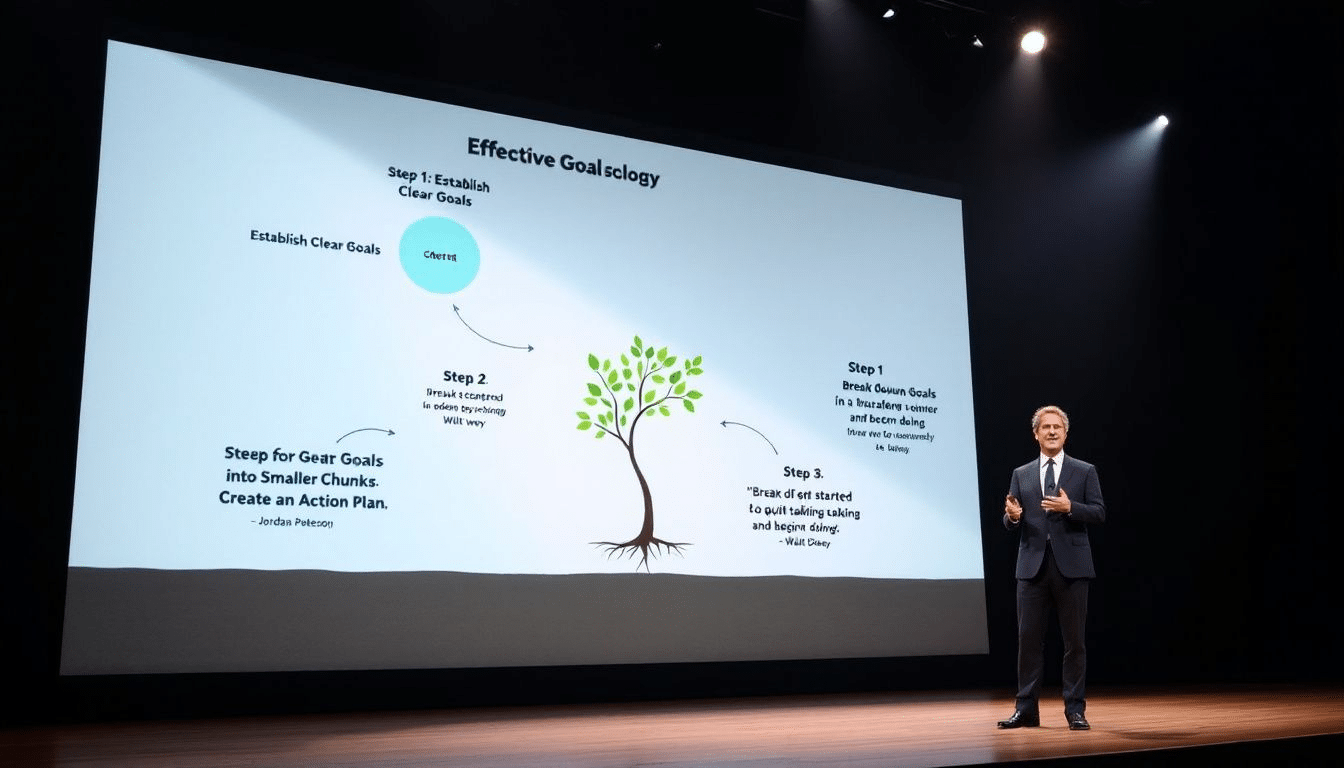Wondering how to set and achieve your goals using Jordan Peterson’s techniques? This article explores Jordan Peterson’s goal setting methods and provides you with practical steps to reach your aspirations, focusing on the principles of Jordan Peterson goal setting.
Key Takeaways
Set clear, high aspirations and break them down into manageable steps for sustainable progress.
Embrace gradual improvements and regularly review your goals to adjust for changing circumstances.
Maintain motivation by finding meaning in your goals and celebrating small wins along the way.
Jordan Peterson Goal Setting: Best Practices for Achieving Success

Jordan Peterson emphasizes the importance of setting personal goals as a way to guide individuals through life’s challenges. According to Peterson, successful individuals possess a clear sense of purpose and direction, which is essential for personal growth and achievement. He advocates for setting high aspirations but stresses the necessity of breaking them down into manageable steps to enhance their achievability.
Making gradual improvements, rather than striving for drastic transformations, is a key strategy endorsed by Peterson. He asserts that small, steady changes are more sustainable and lead to long-term success. Additionally, Peterson highlights the importance of clarity in goal setting. Unclear goals can lead to feelings of hopelessness and overwhelm, making it crucial to manage and clarify your objectives.
Acknowledging issues and failures is another critical aspect of Peterson’s approach. He believes that recognizing and addressing failures is essential for moving forward effectively in goal settings. Utilizing zero-cost strategies like visualization and optimizing your environment can further enhance your pursuit of goals. These practices are designed to help you stay focused, motivated, and on track towards achieving your personal goals.
Introduction
The most important thing you can do to lead a successful life is to set personal goals. Jordan Peterson, a renowned Canadian clinical psychologist, emphasizes the critical role of goal setting for individual development and achievement. Setting high aspirations and breaking them down into smaller, manageable steps is a key strategy endorsed by Peterson. He views personal growth as a journey of incremental improvements rather than large leaps.
The Pareto distribution, which illustrates that a small segment of a population often generates the majority of outcomes, is a concept Peterson explores to explain aspects of success and productivity. He advises against comparing oneself to others, advocating for self-comparison to one’s past self for personal growth.
In this blog post, we will explore these concepts in detail, providing you with actionable strategies to set and achieve your personal goals.
Understanding Jordan Peterson’s Approach to Goal Setting

Jordan Peterson’s approach to goal setting is deeply influenced by his background in psychology. He emphasizes that successful individuals possess a clear sense of purpose and direction in life. This clear sense of direction helps individuals navigate life’s challenges more effectively and stay focused on their long-term objectives.
Peterson advocates for setting high aspirations while ensuring they are broken down into manageable steps. This approach not only makes the goals more achievable but also helps maintain motivation and momentum. Peterson also stresses the importance of making gradual improvements rather than attempting drastic transformations.
Unclear goals can lead to feelings of hopelessness and fail, making it essential to set goals clearly and acknowledge any issues or failures along the way.
The Pareto Principle and Personal Goals
Jordan Peterson often references the Pareto distribution, commonly known as the 80/20 rule, in relation to goal setting. The Pareto distribution indicates that a small proportion of causes (20%) often lead to a large proportion of effects (80%), highlighting the need to identify impactful activities. Applying the Pareto Principle allows individuals to prioritize their efforts, focusing on the activities that yield the greatest results toward their personal goals.
Setting achievable goals is crucial as it aligns with the Pareto Principle, allowing for more effective focus on the activities that drive progress. By identifying and concentrating on the most impactful tasks, you can make significant strides towards achieving your personal goals. This principle not only helps in prioritizing but also ensures that your efforts are directed towards the most productive activities.
Incorporating the Pareto Principle into your goal-setting strategy means focusing on the few tasks that will have the most significant impact on your success. This approach helps in managing time and resources more efficiently, leading to better outcomes and sustained personal growth.
Steps to Effective Goal Setting According to Peterson

Jordan Peterson emphasizes that successful individuals possess a clear sense of purpose and direction in life. He encourages individuals to reflect deeply on their life goals before establishing them, promoting a sense of meaning and purpose. Flexibility in goal setting is crucial, as Peterson notes that aspirations should be reassessed and adjusted according to changing circumstances.
The Pareto Principle suggests that a small portion of effort often leads to the majority of results in goal achievement. Scheduling tasks and creating routines are also important aspects of achieving goals.
Let’s dive deeper into some practical steps Peterson advises for setting and achieving your personal goals.
Broaden Your Perspective
A broader life view can significantly enhance your understanding of personal experiences and aspirations in this world. By broadening your perspective, you can better appreciate your unique path and experiences without constantly comparing yourself to others. This broader perspective allows for greater self-awareness and personal growth, as it enriches the lives of those who embrace it.
Recognizing the value of your unique experiences helps in setting more meaningful and realistic goals. Broader perspectives enable individuals to appreciate their unique paths, fostering a sense of individuality and purpose. This approach not only aids in personal growth but also makes individuals more aware of new opportunities for achieving your goals.
Identify and Understand Your Discontent
Understanding personal discontent is a crucial step in goal setting. It helps individuals recognize their true desires and what they can directly influence. By exploring feelings of discontent, you can clarify your personal ambitions and understand what aspects of life can be realistically controlled.
This process of identifying and understanding personal discontent is essential for setting actionable goals. By understanding what aspects of life you can control, you can take steps towards transforming your desires into clear and achievable goals. This clarity is crucial for effective goal setting and achieving success.
Break Goals into Achievable Tasks
Starting with small tasks lays a foundation for achieving more significant objectives over time. Jordan Peterson advises that making small, incremental changes is often more effective than attempting drastic changes all at once. Gradual progress through small changes is more sustainable and leads to long-term success.
Creating a list of daily tasks not only helps in prioritizing but also fosters accountability for completing them. Breaking down larger goals into smaller, manageable tasks is a fundamental strategy in achieving success. This approach ensures that each step towards your goal is achievable and keeps you motivated throughout the process.
By focusing on small, achievable tasks, you can maintain momentum and avoid feeling overwhelmed. This strategy helps in building confidence and ensuring steady progress towards your larger objectives.
Key Elements of Successful Goal Achievement

Peterson asserts that vague goals can lead to feelings of hopelessness, thus emphasizing the need for clear and specific goals. A clear sense of purpose and direction is essential for effective goal setting. Personal accountability is crucial for goal achievement, with Peterson suggesting that blaming external factors can hinder success.
Recognizing common hindrances in goal setting can improve the likelihood of success. Identifying challenges and learning to overcome them enhances personal growth and resilience, facilitating goal achievement.
Embracing gradual improvements and small, steady changes is more sustainable than drastic transformations. Let’s explore some key elements in detail.
Writing Down Your Goals
Writing down goals is a powerful practice. Documenting goals significantly boosts an individual’s commitment and provides clarity. Without specifying goals, you may sustain misguided hopes, leading to feelings of frustration and failure.
By writing down your goals, you enhance your focus and commitment. This practice helps in understanding your aspirations better and staying motivated throughout the journey. Documenting your goals can significantly enhance your commitment and understanding of your aspirations.
Setting SMART Goals
Setting SMART (Specific, Measurable, Achievable, Relevant, and Time-bound) goals ensures that objectives are clear and reachable. SMART criteria aid in creating clear and attainable objectives, enhancing success rates.
Peterson advocates for personal accountability as essential for achieving goals, highlighting that successful individuals take responsibility for their actions. Setting specific and realistic goals can prevent overwhelm and keep motivation levels high during task completion.
Regular Review and Adjustment
Peterson believes in the importance of regularly reassessing and adjusting goals as life circumstances evolve. Consistent evaluation of goals allows for necessary adjustments based on changing situations. Regular reviews help optimize efforts and resources towards achieving goals.
By regularly reviewing and adjusting your goals, you can ensure alignment with evolving objectives and stay on track towards achieving success.
Overcoming Common Obstacles in Goal Setting
Acknowledging personal failures and actively addressing them is crucial for effective goal setting, according to Peterson. Unclear goals lead to feelings of hopelessness and a sense of failure. Completing daily challenges inspired by Peterson pushed individuals outside of their comfort zones, leading to personal growth and confidence.
Implementing structured time management and working in focused chunks helped individuals avoid burnout and maintain efficiency. Let’s explore some common obstacles and strategies to overcome them.
Dealing with Failure
Dealing with failure requires a mindset centered on resilience, which is essential for personal growth. Adopting a proactive attitude towards failure can help individuals find new strategies to overcome obstacles.
Learning from mistakes is crucial; reflecting on what went wrong can provide valuable insights for future efforts. Ultimately, embracing failure as a part of the learning process fosters resilience and enriches personal development.
Maintaining Motivation
Finding meaning in your goals not only clarifies your intentions but also strengthens your commitment towards achieving them. When you have a meaningful goal, you’re more likely to stay engaged and motivated, even during challenging times.
Celebrating small wins along your journey helps to provide a sense of accomplishment and reinforces your commitment. Both finding meaning in your goals and celebrating small wins are essential strategies for maintaining long-term motivation.
Avoiding Procrastination
Dividing larger tasks into smaller, manageable steps can reduce the tendency to procrastinate. Implementing a structured plan with smaller, manageable tasks can significantly reduce procrastination and encourage progress.
By utilizing these techniques, individuals can effectively combat procrastination and enhance their goal-setting process. This approach creates a clear path toward accomplishment and keeps motivation levels high.
Real-Life Examples and Case Studies
LearnSmarter.ai PLUS has significantly impacted personal growth. It has also contributed to professional development in a transformative way. Success stories from this platform illustrate the effectiveness of the discussed practices.
These real-life examples provide valuable insights into how goal-setting strategies can be applied in various contexts, leading to significant personal and professional achievements that have been achieved.
Additional Resources for Goal Setting

Further reading and resources can significantly enhance your goal-setting capabilities and align with Peterson’s approach. Books, videos, and online tools are valuable resources that provide insights into effective goal setting.
Utilizing available tools and resources can greatly facilitate the achievement of your goals. LearnSmarter.ai PLUS offers Fast Track Courses designed for quick learning of top self-growth books. A 3-day free trial is available for the learning tools provided, allowing exploration of these resources.
Summary
In conclusion, Jordan Peterson’s approach to goal setting offers a comprehensive and actionable framework for personal growth and success. By emphasizing the importance of clear, specific goals and breaking them down into manageable steps, Peterson provides a practical strategy for achieving aspirations. The application of the Pareto Principle further enhances this approach by focusing efforts on the most impactful activities.
As you embark on your goal-setting journey, remember to remain flexible, regularly review and adjust your goals, and celebrate your progress. Embracing failures as learning opportunities and maintaining motivation through meaningful goals will ensure sustained personal growth. Take these principles to heart, and let them guide you towards a more purposeful and successful life.
FAQ
Why is setting clear and specific goals important?
Setting clear and specific goals is essential as it provides direction and helps you track your progress, ultimately leading to success. Embrace this clarity to overcome feelings of hopelessness and stay motivated on your journey!
How does the Pareto Principle apply to goal setting?
To effectively apply the Pareto Principle to your goal setting, concentrate on the 20% of tasks that will yield 80% of the results. By prioritizing these high-impact activities, you’ll make remarkable progress toward your goals!
What are SMART goals?
SMART goals are a powerful way to clarify your objectives by being Specific, Measurable, Achievable, Relevant, and Time-bound. By following this framework, you can enhance your chances of reaching your goals and achieving success!
How can I maintain motivation while working towards my goals?
To maintain motivation while working towards your goals, focus on the meaning behind them and celebrate small wins along the way. This will keep you engaged and remind you of your progress, fueling your commitment to succeed!
What should I do if I encounter failures while pursuing my goals?
Embrace failure as a valuable opportunity to learn and grow. Reflect on your experiences, adapt your strategies, and keep pushing forward with resilience!





